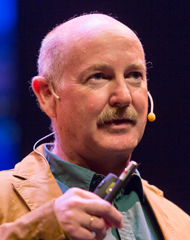The ideologist of the project BRAIN bets at the University for the neuro-rights to guarantee the good use of neurotechnologies.
Rafael Yuste, Full Professor of Columbia University, advocated at the VI ICS Lecture for the inclusion of new clauses in the Universal Declaration of Human Rights regarding these technologies and artificial intelligence.

PHOTO: Manuel Castells
Including neuro-rights in the Universal Declaration of Human Rights can help to ensure "that new neurotechnologies and artificial intelligence are channeled to the benefit of humanity". This was stated at the University of Navarra by Rafael Yuste, Full Professor of Columbia University (USA) and ideologist of project BRAIN.
The expert gave the VI ICS Lecture on Humanities and Social Sciences under the degree scroll 'New neurotechnologies and their impact on science, medicine and society'. The activity was organized by the Institute for Culture and Society (ICS) of the University of Navarra, in the framework of the research developed by the group 'Mind-Brain'.
"Through international projects, new methods are being invented to read brain activity and modify it," he explained. "Brain-computer interfaces are becoming less and less invasive," he added, "which means they are going to be able to be used on more people.
The expert pointed out that this technological revolution "is going to change the rules of the game" and that, although on the one hand "it will mean a new Renaissance", it also "has many social and ethical implications", he emphasized.
Yuste represents a group of international and interdisciplinary researchers and experts who are trying to add new clauses to the Universal Declaration of Human Rights in relation to these advances in order to "protect citizens from possible abuses that may arise from both neurotechnologies and artificial intelligence," he specified.
Specifically, they emphasize four pillars: mental privacy, to prevent the data of mental activity from being used for commercial purposes; identity staff, so that the increase in cognitive capacities does not interfere with people's decision-making capacity; equitable access to technologies, so as not to generate inequalities or privileges; and protection against bias and discrimination against minorities.
In his lecture, Rafael Yuste spoke about the change of perspective in research to understand the mechanisms of the brain. He commented that teams have gone from focusing on the activity of individual neurons, as did Santiago Ramón y Cajal or Charles Schott Sherrington, to studying the joint activity of a large issue of them. He used the simile of a television screen: to understand an image, it is not necessary to look at a specific pixel, but at the set of all the pixels.
This hypothesis is based on the idea that in systems with many units there are emergent properties that are not present in each of those units. This is what happens -he gave as an example- in the atoms of a magnet: they are not magnetic, but the interactions between them do generate this property.
Mapping the brains of small animalsIn this way, he explained that more than 500 laboratories in the U.S. and elsewhere in the world are currently working on the project BRAIN, which was born in 2013 with the goal to push Neuroscience towards understanding the emerging properties of the brain. He noted that this interdisciplinary initiative seeks to develop techniques to record the complete activity of the simplest brains in evolution: worm, fly, fish and mouse. "In five years we aim to decipher the activity of 50,000 neurons; in 10 years, one million neurons; and in 15 years, complete brains of these animals," he said.
To record neuron activity, the researchers use calcium-sensitive substances, which allow them to identify when a neuron fires. "By looking at calcium concentrations, we can discern how neurons interact with each other," he said. In this way they have managed to map the complete activity of a nidaria, the hydra vulgaris. "The bad news," he lamented, "is that we don't understand the relationship between neuron firing and behavior. Most of the activity is spontaneous."
In the case of mice, he revealed that with the two-photon microscope it has been possible to see the activity of a reduced group of neurons, about 2,000. "The neurons fire in groups, like small earthquakes. It is an emerging property that could not have been seen with electrodes," he said. And he acknowledged that it will still take a decade to fully map the brains of these rodents.
All these advances are laying the groundwork instructions, in his opinion, so that one day a general theory can be arrived at that explains how the human brain works. According to Full Professor it will be a finding as revolutionary as the DNA double helix.
Rafael Yuste spoke about these issues at framework of the sixth edition of the ICS Lectures on Humanities and Social Sciences. This is a series of lectures that the research center in Humanities and social sciences of the University of Navarra organizes on an annual basis. These lectures, given by internationally renowned researchers, aim to present to the university community and the general public goal some of the topics being researched in the different ICS projects.
